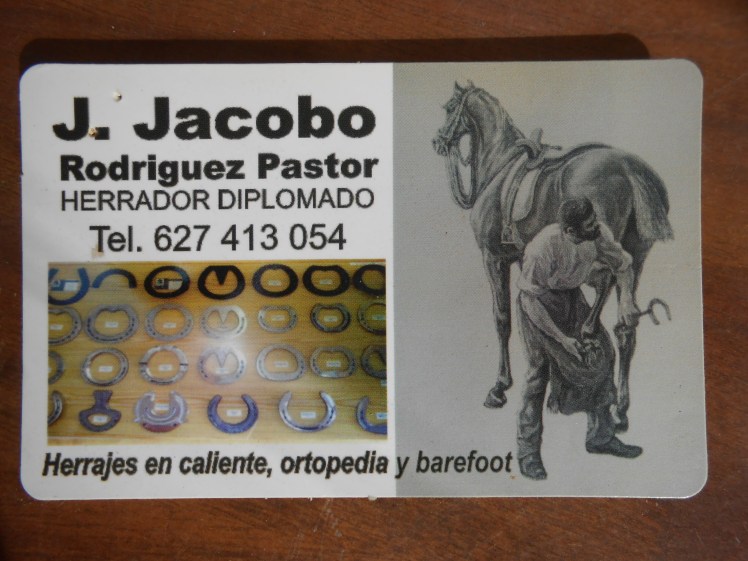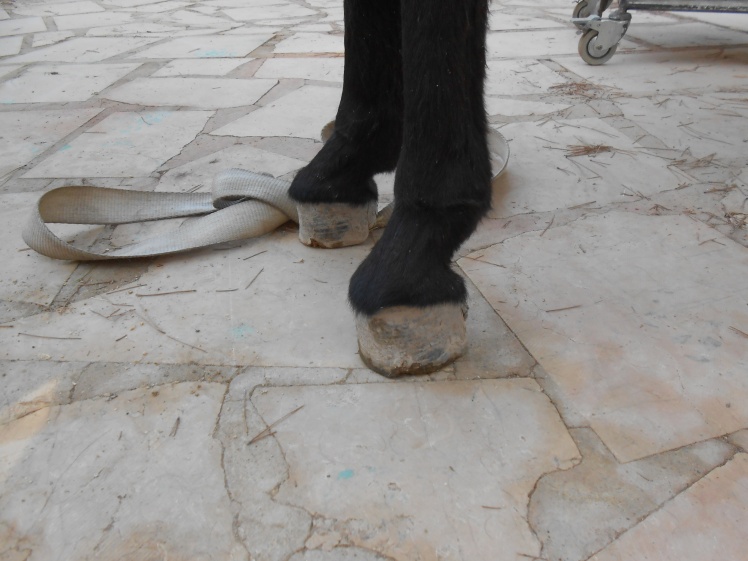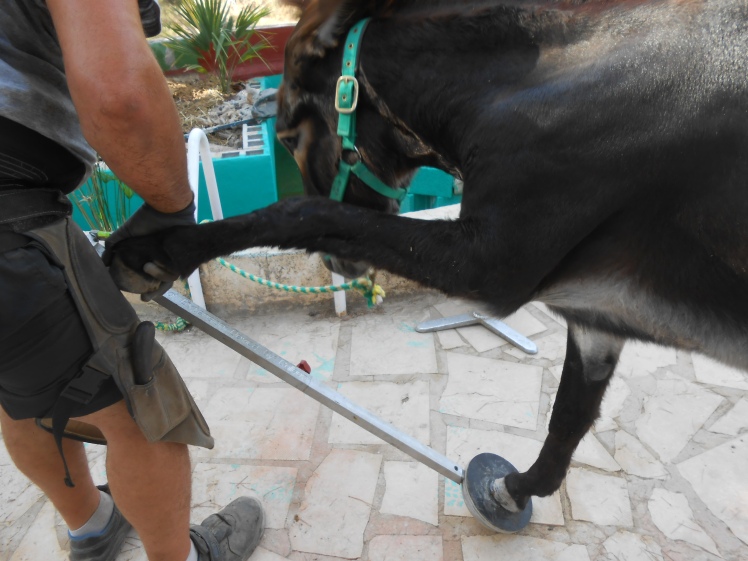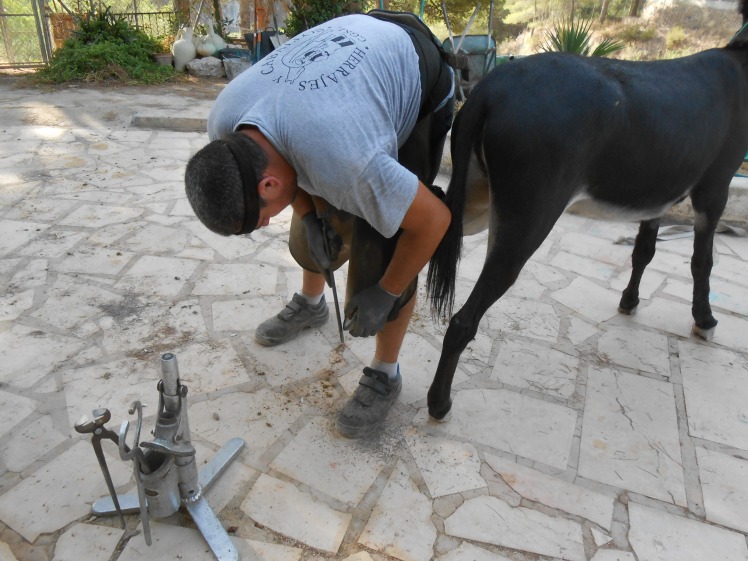First, I’d like to praise the Donkey Sanctuary Sidmouth and the Refugio del Burrito in Spain for their really kind support and concern regarding Aitana. Particular thanks to Nikki in Sidmouth for responding to enquiries from my daughter Alys (as I had been having phone signal problems earlier in the week); Cecilio from Refugio del Burrito, who has taken time to get involved with connecting people regarding Aitana while he is on an important donkey rescue assignment in north eastern Spain; and to Dorothea who Cecilio has put me in touch with in this province and is waiting to see this update so she might comment.
Add to this list the farrier Jacobo who has visited this morning. As with yesterday’s blog post, this is an update for all concerned, so that advice may be given on the latest information available. After the farrier’s visit this morning, we have at least some good news on Aitana’s laminitis problem. Jacobo has worked with my donkeys for three years and I trust his advice completely. The donkeys don’t always cooperate fully with him but he has great patience… and great physical strength to tame them! In fact he is so brilliant I want to put his business card on the blog:

Before Jacobo worked on Aitana he did a general trim of the other three donkeys. We had the usual problems with behaviour when they knew it was the farrier’s visit, and Morris was the badly behaved boy today, breaking away from the lead rope and setting everyone off galloping around the top level. I had already told Jacobo that Aitana was laminitic. He pointed at her, as the donks were throwing up dust all around us like a scene from the Ben Hur chariot race in Rome, and said, «That’s not serious laminitis: see how she is stretching out her legs!»

Jacobo started with a very useful practical advice session on what was involved with the bones and tendons and was almost delivering a one-to-one hoof care tutorial, as he inspected Aitana’s hooves. He speaks Castellano with a very rich Valenciano accent, so that I am almost fooled into thinking I can finally comprehend Valenciano! As we had already seen Aitana galloping a few minutes before, everything Jacobo says is reassuring and geared to solving the problem rather than raising the alarm about the laminitis.
Jacobo’s session with Aitana began by measuring the angle at which her front hooves could stand being elevated. The instrument is a «palanca de extension digital» (no idea what this is in English!) For those technical experts reading this, the angle was 43 degrees on both the right and left untrimmed laminitic hooves.

The hoof trim was designed to take off a small amount of the hoof wall so that it would not put too much pressure on the tendons as they re-adjust to the new hoof angle. Jacobo says we will do a second trim in about two months and I should send him photos of her front hooves to check that everything is going to plan.

Otherwise, he could find no particular hoof or leg problems and he said the incident had been caught in time for Aitana to recover, but she is susceptible to laminitis (some are more susceptible than others) and will always need close observation.
Contrary to my present field arrangements, where the slopes to level 2 have been closed off, due to Aitana’s difficulty descending to join the others, Jacobo said I should reopen the slopes and let her do as she wants. The new hoof angle will give her opportunity to begin flexing the tendons at her own pace.
On the medication, he was surprised I had been advised to keep Aitana on EQzona twice daily into a second week. (I had just ordered 16 more sachets from the farmacia for delivery on Monday.) He said equines should only be given that for a short period because it can cause stomach problems. (I think the word was Spanish for ulcers but I don’t know for sure.) He said change to Danilon, which is cheaper and safer, or if she is not obviously in pain, cease the painkiller!
The really interesting advice was on diet. I had been feeling terrible ever since the laminitis diagnosis because I wondered if the small amount of grain feed the donkeys get (250g once per day for digestion) might have caused the laminitis through too much protein. Jacobo asked to see the grain (pienso). This is a Corcel horse product containing wheat and barley grains, a very small amount of alfalfa pellets, a few bits of algaroba, etc. A third of a scoop once a day. I had been informed originally by a previous vet in 2011 that a very small quantity of this was good for the digestion if their diet was mainly wheat straw.
Jacobo said this product was low sugar and in any case, in the quantity the donkeys are getting, it could be considered as a treat rather than a main part of their diet. To cut out this, or cut out the small amount of alfalfa 10% that goes into their straw mix, could produce a reaction in donkeys losing their appetite if they find the food boring.
Conclusion:
After Jacobo’s visit I am very reassured the laminitis is under control and Aitana’s susceptibility can be managed in future. I have to make some decisions on the advice about the painkiller: my instinct is to cease at the weekend. Aitana has always been a delicate donkey: it is a bit of a joke with my daughter that Aitana has carrot days and non-carrot days, and tends to be fussy and obsessive about food. She is always first to start braying if food is late coming.
The other problem, as discussed in yesterday’s post, is the weight-loss issue. The farrier’s visit was not meant to address that, nor did he comment on it because it is not his field. We await the laboratory test.
After waking up at 3am worrying about Aitana again, I am pleased to say that I am now enjoying a very early beer this morning, and feeling very very reassured after Jacobo’s visit. I should add that he only wanted to charge me the same amount that he charges for a normal visit – with no extra for the laminitis examination, tutorial, and expertise with the hoof management. Naturally I gave him a tip. He is first class. Gracias, amigo. Aqui tenemos un profesiónal.
What is needed now is similar professional advice and management of the weight loss problem: what caused it, and how do we address it?
And I am still interested in the timing with the ‘flu/tet innoculation. If this animal had been identified as laminitic on 4 July, as photographic evidence shows she should have been, would it have been wise to innoculate her? I think there could be a general professional learning point here that goes beyond the individual problem with my Aitana.

17 August 2.30 pm
After a massage of her front legs from me (thanks to Penny Holtzem in Finestrat for instructing me on correct way to massage Aitana), Aitana has followed her mother down the slope to level 2. She went slowly but without any hesitation. She had an argument with Morris and hurried back up the opposite slope. Going up has not been a difficulty, but the unhesitating descent was like a small miracle.





Hi Gareth,
So pleased that Aitana got the help she (and you) needed, and well done Alys for her part in things. All the best to you both, and give Aitana a knuckle-scrub round the ears from me. Maggie xxx
Me gustaLe gusta a 1 persona
Yes, Maggie: you’ve no idea how relieved I am. A long-awaited summer holiday, and a chance to sit back and enjoy life with the donks, was turning fast into a nightmare.
We haven’t yet resolved the weight-loss question but I have now also been reassured that the vet’s visual analysis of the blood sample was wrong anyway. When she said «look at that white fatty substance on top» and described it to me as grasa («fat») in the blood, the conversation moved within thirty seconds to the possibility of hyperlipaemia, which I’d never heard of, but which a few minutes research showed can kill a donkey within a very short time.
It has now been suggested to me this morning by the Spanish Donkey Sanctuary recommended vet, «What you saw on the blood was not lipids but small aggregates of white blood cells… usually you cannot see the fat in the plasma before centrifugation of the blood.»
So I’m lying awake at three o’clock this morning wondering how my other donkeys would react if Aitana didn’t make it, and my vet doesn’t know what she is talking about? Yes it is a great relief, but I may be excused for also beginning to feel angry about being misinformed. On a number of matters.
Thanks for your interest. Aitana news will continue until we have everything clear. Take care. x
Me gustaMe gusta
I’ll keep Aitana in my prayers.
Me gustaMe gusta
I hope she recovers quickly.
Me gustaMe gusta
Thank you, Mary and Sheel.
Aitana is definitely looking better after the farrier’s work. I’m expecting the blood test result today.
Me gustaMe gusta
If there was an Olympic hoofcare event, Jacobo would be up there with gold!
Me gustaMe gusta
Hi Gareth, just catching up with your worrying news of laminitis. As an ex-horse owner and rider of many years, my heart sank when I read this as I know how serious this problem can be. In donkeys, I have no knowledge, but looking at the photos of her hooves prior to farrier intervention made me gulp. However….there are other options available to improve her overall constitution and lessen the liability of more laminitis outbreaks. I am a retired homoepath and used to prescribe frequently for animals with all sorts of problems. Laminitis is one such complaint which can be treated well with these wonderful medicines. I will send you more information over the weekend, but you should be able to find quite a lot on the internet now about veterinary homoeopathy and the medicines available and used to treat small and large animals. If you are not able to get any remedies in a pharmacy near you, you can always get them sent to you from one of the big homoepathic pharmacies here in the UK. They ship all over the world. I’ll get you more info later, but very glad to hear that Aitana seems a little better.
Best wishes to you all,
Mary
Me gustaLe gusta a 1 persona
Hi Mary,
Many thanks for the homeopathy advice. I don’t know anything about that but will certainly follow up your suggestions and make some enquiries. I don’t know if you’ve seen today’s update but I have posted the blood analysis. It is now being looked at my a vet recommended by the Spanish branch of the Donkey Sanctuary, Refugio del Burrito.
Just waiting for news now.
Me gustaMe gusta